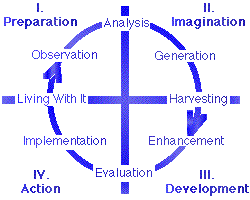
|| Take me back to the main ToolKit
page ||
|| Take me back to the DirectedCreativity Home page
||
Information on this page...
|| Why have a model?
||
|| Review of creativity models in the literature
||
|| Walk-through of the DirectedCreativity cycle
||
Click on the up arrow ![]() to return to this navigation
menu
to return to this navigation
menu
In contrast to heuristic statements that provide a focused gem of wise advice, models strive to capture the whole of something in a overall, integrated fashion. Models also show sequence, interconnection, pattern, flow, and organization. Models are critically important to mental functioning because they allow us to anticipate future actions, needs, and steps.
![]() There are
many models proposed in the creativity literature for the process of creative
thinking. Arieti (1976) catalogued eight such models that were proposed
during the period 1908 to 1964. There have been several additional models
proposed since. Analysis of these various models reveals some consistent
patterns. (Click here for a working paper
that reviews several creativity models and illustrates these patterns.)
There are
many models proposed in the creativity literature for the process of creative
thinking. Arieti (1976) catalogued eight such models that were proposed
during the period 1908 to 1964. There have been several additional models
proposed since. Analysis of these various models reveals some consistent
patterns. (Click here for a working paper
that reviews several creativity models and illustrates these patterns.)
These insights from a review of the many models of creative thinking should be encouraging to us. Serious business people often have strong skills in practical, scientific, concrete, and analytical thinking. Contrary to popular belief, the modern theory of creativity does not require that we discard these skills. What we do need to do, however, is to supplement these with some new thinking skills to support the generation of novel insights and ideas.
![]() The graphic
presents our synthesis model -- The DirectedCreativity Cycle -- based on
the concepts behind the various models proposed
in the literature over the last 80 years.
The graphic
presents our synthesis model -- The DirectedCreativity Cycle -- based on
the concepts behind the various models proposed
in the literature over the last 80 years.

Let's walk through it, beginning at the 9:00 position on the circle. We live everyday in the same world as everyone else, but creative thinking begins with careful observation of that world coupled with thoughtful analysis of how things work and fail. These mental processes create a store of concepts in our memories. Using this store, we generate novel ideas to meet specific needs by actively searching for associations among concepts. Seeking the balance between satisficing and premature judgment, we then harvest and further enhance our ideas before we subject them to a final, practical evaluation. But, it is not enough just to have creative thoughts; ideas have no value until we put in the work to implement them. Every new idea that is put into practice (that is, every innovation) changes the world we live in, which re-starts the cycle of observation and analysis.
Directed creativity simply means that we make purposeful mental movements to avoid the pitfalls associated with our cognitive mechanisms at each step of this process.
For purposes of explanation, we can further divide this model into the four phases shown. We will use these four phases of Preparation, Imagination, Development, and Action to organize the tools of directed creativity.
![]() Note that
this model continues in the tradition of others
in asserting that creativity is a balance of imagination and analysis. The
model also purposefully avoids taking a stand on the controversy of whether
imagination is a conscious or subconscious mental ability. While I personally
believe that imagination is a conscious, non-magical mental action, the
activity of "generation" in the model welcomes creative ideas
regardless of their source. Finally, notice that this model clearly supports
the notion that innovation is a step beyond the simple generation of creative
ideas; the Action phase of the model makes it clear that creative ideas
have value only when they are implemented in the real world.
Note that
this model continues in the tradition of others
in asserting that creativity is a balance of imagination and analysis. The
model also purposefully avoids taking a stand on the controversy of whether
imagination is a conscious or subconscious mental ability. While I personally
believe that imagination is a conscious, non-magical mental action, the
activity of "generation" in the model welcomes creative ideas
regardless of their source. Finally, notice that this model clearly supports
the notion that innovation is a step beyond the simple generation of creative
ideas; the Action phase of the model makes it clear that creative ideas
have value only when they are implemented in the real world.
Back to Top of
Page
Take me back to the main ToolKit page
© 1997 Paul E. Plsek & Associates, Inc.
All rights reserved.
|| Home Page || What's Directed Creativity? || Who's Paul Plsek? || Services
||
|| Links to Other Sites || The Creativity Bookstore ||
|| Creativity, Innovation,
and Quality by Paul Plsek ||
DirectedCreativity Theory, Methods, and Tools...
|| DirectedCreativity Cycle ||
|| DirectedCreativity Heuristics
||
|| DirectedCreativity Toolkit
||